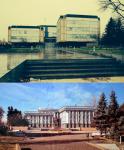One of the major factors of urban change in Skopje was an earthquake on July 26, 1963 (when the country was a part of Yugoslavia). About 80 percent of the city was destroyed. Along with aid from the international community, a limited competition for the redevelopment of the city was created. In 1965 Kenzo Tange won 60% of the prize with 40% going to the Yugoslav team. Tanges plan would have the city bound together with the symbolic concepts of its "gate" and "wall", serving both as programmatic features and metaphors for the urban form. The City Gate was characterized by the convergence of all traffic systems, while the railway terminal was designed as an underground structure. Pedestrian zones, transit terminals, automobile parking decks would occupy different levels above it.
Brutalist Skopje
After this redevelopment period and the 1960s, Skopje would be classified by Brutalist architecture, which gives the city a retro-futuristic, fortress feel and look. Its also In many ways I think this is a physical representation of what the people wanted, a sense of power & strength, which gives a feeling of security. In addition to this the style was in many ways cost effective.
Skopje 2014
After the declaration of independence in 1991 with the push towards a more free-market economy would come further changes to the urban landscape. New seemingly radical designs would rise in opposition to the countrys socialist past. With the country trying to propel itself into prominence & speak to the growing nationalism came the announcement, in 2010, of the Skopje 2014 Project by the VMRO-DPMNE (ruling party, of which the President & Prime Minister are members). The project would see the rise of retro-antique buildings, with monumental-nationalistic statues and public art as well. The facade on this building was changed, at a cost of 10 million Euro dollars, from classic 1970 – to a fake, neoclassical style. This is only one of a number of radical reconstructions of modernist architecture in Skopje in the recent years
Source: http://architectuul.com/architecture/government-building
1969
1970
Petar Mulichkoski



